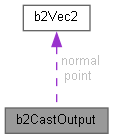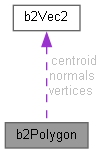|
Box2D 3.0.0
A 2D physics engine for games
|
|
Box2D 3.0.0
A 2D physics engine for games
|
Data Structures | |
| struct | b2RayCastInput |
| Low level ray-cast input data. More... | |
| struct | b2ShapeCastInput |
| Low level shape cast input in generic form. More... | |
| struct | b2CastOutput |
| Low level ray-cast or shape-cast output data. More... | |
| struct | b2MassData |
| This holds the mass data computed for a shape. More... | |
| struct | b2Circle |
| A solid circle. More... | |
| struct | b2Capsule |
| A solid capsule can be viewed as two semicircles connected by a rectangle. More... | |
| struct | b2Polygon |
| A solid convex polygon. More... | |
| struct | b2Segment |
| A line segment with two-sided collision. More... | |
| struct | b2SmoothSegment |
| A smooth line segment with one-sided collision. More... | |
| struct | b2Hull |
| A convex hull. Used to create convex polygons. More... | |
Macros | |
| #define | b2_maxPolygonVertices 8 |
| The maximum number of vertices on a convex polygon. | |
Functions | |
| bool | b2IsValidRay (const b2RayCastInput *input) |
| Validate ray cast input data (NaN, etc) | |
| b2Polygon | b2MakePolygon (const b2Hull *hull, float radius) |
| Make a convex polygon from a convex hull. This will assert if the hull is not valid. | |
| b2Polygon | b2MakeOffsetPolygon (const b2Hull *hull, float radius, b2Transform transform) |
| Make an offset convex polygon from a convex hull. This will assert if the hull is not valid. | |
| b2Polygon | b2MakeSquare (float h) |
| Make a square polygon, bypassing the need for a convex hull. | |
| b2Polygon | b2MakeBox (float hx, float hy) |
| Make a box (rectangle) polygon, bypassing the need for a convex hull. | |
| b2Polygon | b2MakeRoundedBox (float hx, float hy, float radius) |
| Make a rounded box, bypassing the need for a convex hull. | |
| b2Polygon | b2MakeOffsetBox (float hx, float hy, b2Vec2 center, float angle) |
| Make an offset box, bypassing the need for a convex hull. | |
| b2Polygon | b2TransformPolygon (b2Transform transform, const b2Polygon *polygon) |
| Transform a polygon. This is useful for transferring a shape from one body to another. | |
| b2MassData | b2ComputeCircleMass (const b2Circle *shape, float density) |
| Compute mass properties of a circle. | |
| b2MassData | b2ComputeCapsuleMass (const b2Capsule *shape, float density) |
| Compute mass properties of a capsule. | |
| b2MassData | b2ComputePolygonMass (const b2Polygon *shape, float density) |
| Compute mass properties of a polygon. | |
| b2AABB | b2ComputeCircleAABB (const b2Circle *shape, b2Transform transform) |
| Compute the bounding box of a transformed circle. | |
| b2AABB | b2ComputeCapsuleAABB (const b2Capsule *shape, b2Transform transform) |
| Compute the bounding box of a transformed capsule. | |
| b2AABB | b2ComputePolygonAABB (const b2Polygon *shape, b2Transform transform) |
| Compute the bounding box of a transformed polygon. | |
| b2AABB | b2ComputeSegmentAABB (const b2Segment *shape, b2Transform transform) |
| Compute the bounding box of a transformed line segment. | |
| bool | b2PointInCircle (b2Vec2 point, const b2Circle *shape) |
| Test a point for overlap with a circle in local space. | |
| bool | b2PointInCapsule (b2Vec2 point, const b2Capsule *shape) |
| Test a point for overlap with a capsule in local space. | |
| bool | b2PointInPolygon (b2Vec2 point, const b2Polygon *shape) |
| Test a point for overlap with a convex polygon in local space. | |
| b2CastOutput | b2RayCastCircle (const b2RayCastInput *input, const b2Circle *shape) |
| Ray cast versus circle in shape local space. Initial overlap is treated as a miss. | |
| b2CastOutput | b2RayCastCapsule (const b2RayCastInput *input, const b2Capsule *shape) |
| Ray cast versus capsule in shape local space. Initial overlap is treated as a miss. | |
| b2CastOutput | b2RayCastSegment (const b2RayCastInput *input, const b2Segment *shape, bool oneSided) |
| Ray cast versus segment in shape local space. | |
| b2CastOutput | b2RayCastPolygon (const b2RayCastInput *input, const b2Polygon *shape) |
| Ray cast versus polygon in shape local space. Initial overlap is treated as a miss. | |
| b2CastOutput | b2ShapeCastCircle (const b2ShapeCastInput *input, const b2Circle *shape) |
| Shape cast versus a circle. Initial overlap is treated as a miss. | |
| b2CastOutput | b2ShapeCastCapsule (const b2ShapeCastInput *input, const b2Capsule *shape) |
| Shape cast versus a capsule. Initial overlap is treated as a miss. | |
| b2CastOutput | b2ShapeCastSegment (const b2ShapeCastInput *input, const b2Segment *shape) |
| Shape cast versus a line segment. Initial overlap is treated as a miss. | |
| b2CastOutput | b2ShapeCastPolygon (const b2ShapeCastInput *input, const b2Polygon *shape) |
| Shape cast versus a convex polygon. Initial overlap is treated as a miss. | |
| b2Hull | b2ComputeHull (const b2Vec2 *points, int32_t count) |
| Compute the convex hull of a set of points. | |
| bool | b2ValidateHull (const b2Hull *hull) |
| This determines if a hull is valid. | |
Geometry types and algorithms
Definitions of circles, capsules, segments, and polygons. Various algorithms to compute hulls, mass properties, and so on.
| struct b2RayCastInput |
| struct b2ShapeCastInput |
Low level shape cast input in generic form.
This allows casting an arbitrary point cloud wrap with a radius. For example, a circle is a single point with a non-zero radius. A capsule is two points with a non-zero radius. A box is four points with a zero radius.

| Data Fields | ||
|---|---|---|
| int32_t | count | The number of points. |
| float | maxFraction | The maximum fraction of the translation to consider, typically 1. |
| b2Vec2 | points[b2_maxPolygonVertices] | A point cloud to cast. |
| float | radius | The radius around the point cloud. |
| b2Vec2 | translation | The translation of the shape cast. |
| struct b2CastOutput |
Low level ray-cast or shape-cast output data.

| Data Fields | ||
|---|---|---|
| float | fraction | The fraction of the input translation at collision. |
| bool | hit | Did the cast hit? |
| int32_t | iterations | The number of iterations used. |
| b2Vec2 | normal | The surface normal at the hit point. |
| b2Vec2 | point | The surface hit point. |
| struct b2MassData |
This holds the mass data computed for a shape.

| Data Fields | ||
|---|---|---|
| b2Vec2 | center | The position of the shape's centroid relative to the shape's origin. |
| float | I | The rotational inertia of the shape about the local origin. |
| float | mass | The mass of the shape, usually in kilograms. |
| struct b2Circle |
| struct b2Capsule |
| struct b2Polygon |
A solid convex polygon.
It is assumed that the interior of the polygon is to the left of each edge. Polygons have a maximum number of vertices equal to b2_maxPolygonVertices. In most cases you should not need many vertices for a convex polygon.

| Data Fields | ||
|---|---|---|
| b2Vec2 | centroid | The centroid of the polygon. |
| int32_t | count | The number of polygon vertices. |
| b2Vec2 | normals[b2_maxPolygonVertices] | The outward normal vectors of the polygon sides. |
| float | radius | The external radius for rounded polygons. |
| b2Vec2 | vertices[b2_maxPolygonVertices] | The polygon vertices. |
| struct b2Segment |
| struct b2SmoothSegment |
A smooth line segment with one-sided collision.
Only collides on the right side. Several of these are generated for a chain shape. ghost1 -> point1 -> point2 -> ghost2

| Data Fields | ||
|---|---|---|
| int32_t | chainId | The owning chain shape index (internal usage only) |
| b2Vec2 | ghost1 | The tail ghost vertex. |
| b2Vec2 | ghost2 | The head ghost vertex. |
| b2Segment | segment | The line segment. |
| struct b2Hull |
A convex hull. Used to create convex polygons.

| Data Fields | ||
|---|---|---|
| int32_t | count | The number of points. |
| b2Vec2 | points[b2_maxPolygonVertices] | The final points of the hull. |
| #define b2_maxPolygonVertices 8 |
The maximum number of vertices on a convex polygon.
Changing this affects performance even if you don't use more vertices.
Compute the convex hull of a set of points.
Returns an empty hull if it fails. Some failure cases:
| b2CastOutput b2RayCastSegment | ( | const b2RayCastInput * | input, |
| const b2Segment * | shape, | ||
| bool | oneSided ) |
Ray cast versus segment in shape local space.
Optionally treat the segment as one-sided with hits from the left side being treated as a miss.
| bool b2ValidateHull | ( | const b2Hull * | hull | ) |
This determines if a hull is valid.
Checks for: